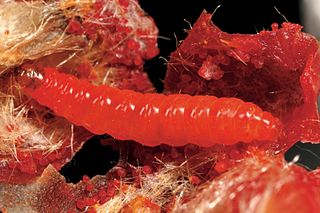
Hyposmocoma is a genus of moths with more 350 species endemic to the Hawaiian Islands. The genus was first described by Arthur Gardiner Butler in 1881. Most species of Hyposmocoma have plant-based diets, but four species, such as Hyposmocoma molluscivora, eat snails. The caterpillars spin silk, which they then use to capture and eat snails. These are the first caterpillars known to eat snails.

Cydia is a large genus of tortrix moths, belonging to the tribe Grapholitini of subfamily Olethreutinae. Its distinctness from and delimitation versus the tribe's type genus Grapholita requires further study.

Cochylis is a genus of moths belonging to the subfamily Tortricinae of the family Tortricidae.

Xyloryctidae is a family of moths contained within the superfamily Gelechioidea described by Edward Meyrick in 1890. Most genera are found in the Indo-Australian region. While many of these moths are tiny, some members of the family grow to a wingspan of up to 66 mm, making them giants among the micromoths.

Glyphipterix is a genus of sedge moths. It was described by Jacob Hübner in 1825.

Carposina is a genus of moths in the Carposinidae family.
Metathrinca ancistrias is a moth in the family Xyloryctidae. It was described by Edward Meyrick in 1906. It is found in Sri Lanka.
Metathrinca is a genus of moths of the family Xyloryctidae.
Metathrinca ceromorpha is a moth in the family Xyloryctidae. It was described by Edward Meyrick in 1923. It is found in Assam, India.
Metathrinca illuvialis is a moth in the family Xyloryctidae. It was described by Edward Meyrick in 1914. It is found in Assam, India.
Metathrinca intacta is a moth in the family Xyloryctidae. It was described by Edward Meyrick in 1938. It is found in Yunnan, China.
Metathrinca loranthivora is a moth in the family Xyloryctidae. It was described by Edward Meyrick in 1937. It is found on Java in Indonesia.
Metathrinca parabola is a moth in the family Xyloryctidae. It was described by Edward Meyrick in 1914. It is found in southern India.
Metathrinca memnon is a moth in the family Xyloryctidae. It was described by Edward Meyrick in 1914. It is found in Sri Lanka.
Metathrinca ophiura is a moth in the family Xyloryctidae. It was described by Edward Meyrick in 1908. It is found in Sri Lanka.
Metathrinca coenophyes is a moth in the family Xyloryctidae. It was described by Alexey Diakonoff in 1968. It is found on Luzon in the Philippines.
Metathrinca iridostoma is a moth in the family Xyloryctidae. It was described by Alexey Diakonoff in 1968. It is found on Luzon in the Philippines.
Metathrinca pernivis is a moth in the family Xyloryctidae. It was described by Alexey Diakonoff in 1968. It is found on Mindanao in the Philippines.
Metathrinca sinumbra is a moth in the family Xyloryctidae. It was described by Alexey Diakonoff in 1968. It is found on Luzon in the Philippines.





